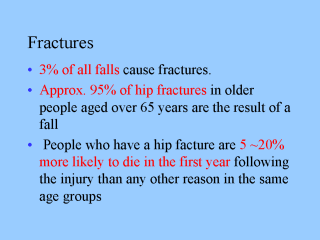| front |1 |2 |3 |4 |5 |6 |7 |8 |9 |10 |11 |12 |13 |14 |15 |16 |17 |18 |19 |20 |21 |22 |23 |24 |25 |26 |27 |28 |29 |30 |31 |32 |review |
 |
Let's talk about
two consequences of a fall. Falls account for 87% of all fractures for people 65 years and older. An estimated 1 ~ 2 % of of falls cause hip fractures which account for the majority of fall-related morbidity and mortality; 3~ 5 % of falls result in other type of fractures, e.g. hand, and ankle fractures (Sattin 1992). The most common sites of fractures include hip, spine, hand, forearm, leg and ankle. Nine out of ten hip fracture in older people result from a fall. People who have a hip fracture are 5 ~20% more likely to DIE in the first year following that injury than any other reason. Falls are related to placement of nursing home care. Compared with elderly persons who are non-fallers, elder persons who have fallen need three times more requirement of nursing home care. 20% of older persons who hospitalized did not able to return to home but had to go to rehabilitation facilities or dependent living (Kiel et al., 1991). |